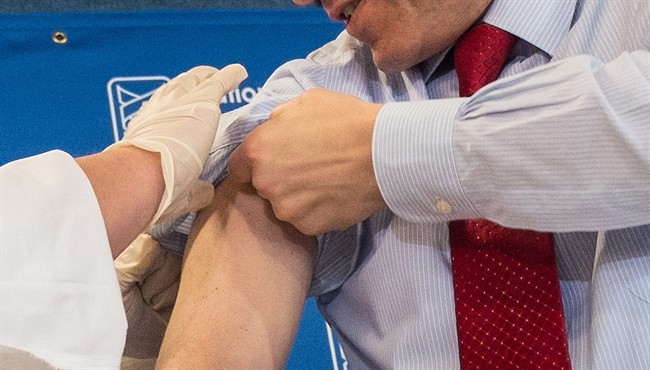Last year’s flu vaccine wasn’t an ideal match to combat the season’s nasty H3N2 virus. In new research, scientists say it was a single mutation that caused the drift, making the vaccine less than 20 per cent effective.

Viruses are cunning, constantly making tweaks to their attack plan in getting you sick. In this case, the H3N2 virus acquired a mutation that concealed the infection from the immune system, American researchers suggest.
READ MORE: This year’s flu shot may not be the right match, CDC tells doctors
“Flu vaccines work best when they are similar to most circulating flu strains,” lead author, Dr. Scott Hensley of the Wistar Insitute, said.
“The World Health Organization recently recommended that a new H3N2 component should be incorporated into future formulations of seasonal flu vaccines. Our studies support this decision, since most circulating H3N2 strains are mismatched to the 2014-2015 vaccine strain,” Hensley explained.
Each year, strains of the influenzas mutate and re-emerge, infecting victims and triggering a new season. Those of us in the northern hemisphere keep a watchful eye over the flu in the southern hemisphere, which affects residents during their winter (or our summer).
READ MORE: Nasty flu season strikes as H3N2 cases spike across Canada
Scientists look at the patterns and make their predictions based on what viruses made their rounds below us and estimate what mutations could occur before the influenzas make their way over the equator.
- Canadian man dies during Texas Ironman event. His widow wants answers as to why
- ‘Sciatica was gone’: hospital performs robot-assisted spinal surgery in Canadian first
- Canadians more likely to eat food past best-before date. What are the risks?
- Treatment from female doctors leads to lower death rates, study finds
Picking out three strains for a vaccine is guesswork, and by the time influenza makes its way into the northern hemisphere, it’s had time to mutate or “drift.” But by then, the flu vaccine is already formulated.
READ MORE: The flu vaccine didn’t work in Europe either, research suggests
The “drift” made the vaccine last season nearly useless: North American health officials pegged efficacy at about 20 per cent, while their European counterparts say the shot protected about three per cent of people who got vaccinated. These were some of the worst results recorded since doctors began tracking how well vaccines work. Ideally, the best flu vaccines are 50 to 60 per cent effective.
Hensley and his team looked at what went wrong with the H3N2 strain by playing with variations of the virus and a key protein called hemagglutin, which helps the infection stick to our cells. They wanted to find out which viruses would be recognized by antibodies in the blood that would rally to fight the sickness.
READ MORE: Flu vaccine only 23 per cent effective this season, CDC says
Turns out, the strain that contained a stealthy mutation made it difficult for antibodies to pick up on the virus.
“We find that some human immune responses are heavily focused on single regions of the flu virus and that single viral mutations can evade these immune responses,” Hensley said.
But he’s still urging the public to get the flu shot, echoing health officials’ sentiments.
“Most years, vaccine strains are well matched to most circulating strains, and seasonal flu vaccines are usually more effective. The best way to prevent flu infection is by getting a flu vaccine,” he said.
READ MORE: Flu vaccine offered little or no protection in Canada this year
While it may not protect against this one strain of the flu, it’ll still fight against other strains floating around. It’ll also lessen the risk of complications.
“Though reduced, the cross-protection might reduce the likelihood of severe outcomes such as hospitalization and death,” the CDC advisory said to American doctors when it discovered the mismatch.
Read more about who should be vaccinated here.
READ MORE: Nasty H3N2 flu season worsens as cases rise across Canada
Hensley’s full findings were published Thursday afternoon in the journal Cell Reports.
carmen.chai@globalnews.ca
Follow @Carmen_Chai


Comments